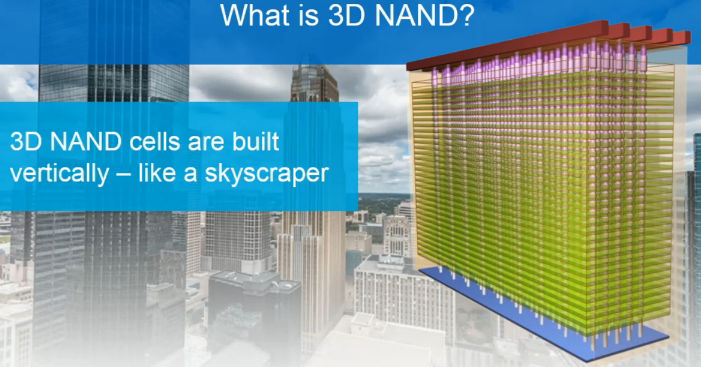Micron Technology, Inc., and Intel Corporation today revealed the availability of their 3D NAND technology, the world’s highest-density flash memory. Micron is a global leader in advanced semiconductor systems. Micron’s broad portfolio of high-performance memory technologies, including DRAM, NAND and NOR Flash. It is the basis for solid state drives, modules, multichip packages and other system solutions. Intel is a world leader in computing innovation. The company designs and builds the essential technologies that serve as the foundation for the world’s computing devices.
 Micron and Intel unveil new 3D NAND Flash Memory Technology Advancements enable three times more capacity than Other NAND Technologies. 3D NAND technology uses floating gate cells and enables the highest-density flash device ever developed—three times higher capacity than other NAND die in production. Enables gum stick-sized SSDs with more than 3.5 terabytes (TB) of storage and standard 2.5 inch SSDs with greater than 10TB.
Micron and Intel unveil new 3D NAND Flash Memory Technology Advancements enable three times more capacity than Other NAND Technologies. 3D NAND technology uses floating gate cells and enables the highest-density flash device ever developed—three times higher capacity than other NAND die in production. Enables gum stick-sized SSDs with more than 3.5 terabytes (TB) of storage and standard 2.5 inch SSDs with greater than 10TB.
This enables more storage in a smaller space, bringing significant cost savings, low power usage and high performance to a range of mobile consumer devices as well as the most demanding enterprise deployments. The singly layer manufacturing process of NAND flash practically approaching the limits of the escalation, placing significant restrictions on memory manufacturers. 3D NAND technology is poised to make a significant impact, by keeping flash storage solutions aligned with Moore’s Law, the trajectory for continued performance gains and cost savings, driving more widespread use of flash storage.
One of the most significant aspects of this technology is in the foundational memory cell itself. Intel and Micron chose to use a floating gate cell, a universally utilized design refined through years of high-volume planar flash manufacturing. This is the first use of a floating gate cell in 3D NAND, which was a key design choice to enable greater performance and increase quality and reliability.
 The new 3D NAND technology stacks flash cells vertically in 32 layers to achieve 256Gb multilevel cell (MLC) and 384Gb triple-level cell (TLC) die that fit within a standard package. These capacities can enable gum stick-sized SSDs with more than 3.5TB of storage and standard 2.5-inch SSDs with greater than 10TB. Because capacity is achieved by stacking cells vertically, the individual cell dimensions can be considerably larger. This is expected to increase both performance and endurance and make even the TLC designs well-suited for data center storage.
The new 3D NAND technology stacks flash cells vertically in 32 layers to achieve 256Gb multilevel cell (MLC) and 384Gb triple-level cell (TLC) die that fit within a standard package. These capacities can enable gum stick-sized SSDs with more than 3.5TB of storage and standard 2.5-inch SSDs with greater than 10TB. Because capacity is achieved by stacking cells vertically, the individual cell dimensions can be considerably larger. This is expected to increase both performance and endurance and make even the TLC designs well-suited for data center storage.
The key product features of this 3D NAND design include, first large capacities up to 48GB of NAND per die, which enables three-fourths of a terabyte to fit in a single fingertip-sized package. Second reduced cost per GB, fast and high read or write bandwidth, I/O speeds and random read performance. Third, it’s eco-friendly because of new sleep modes enable low-power use by cutting power to inactive NAND die, dropping power consumption significantly in standby mode. And last but not least it’s smart because innovative new features improve latency and increase endurance over previous generations, and also make system integration easier.
